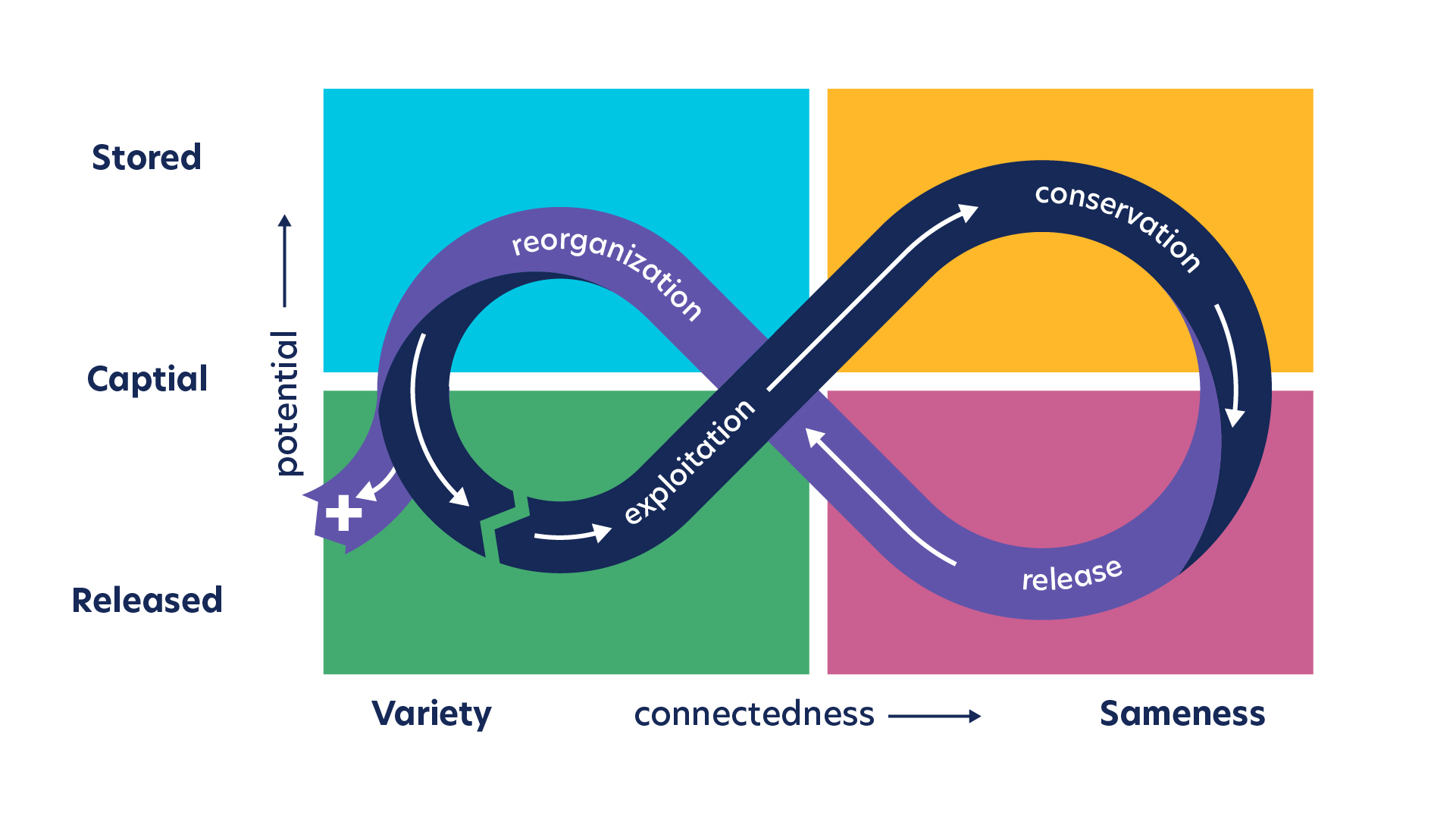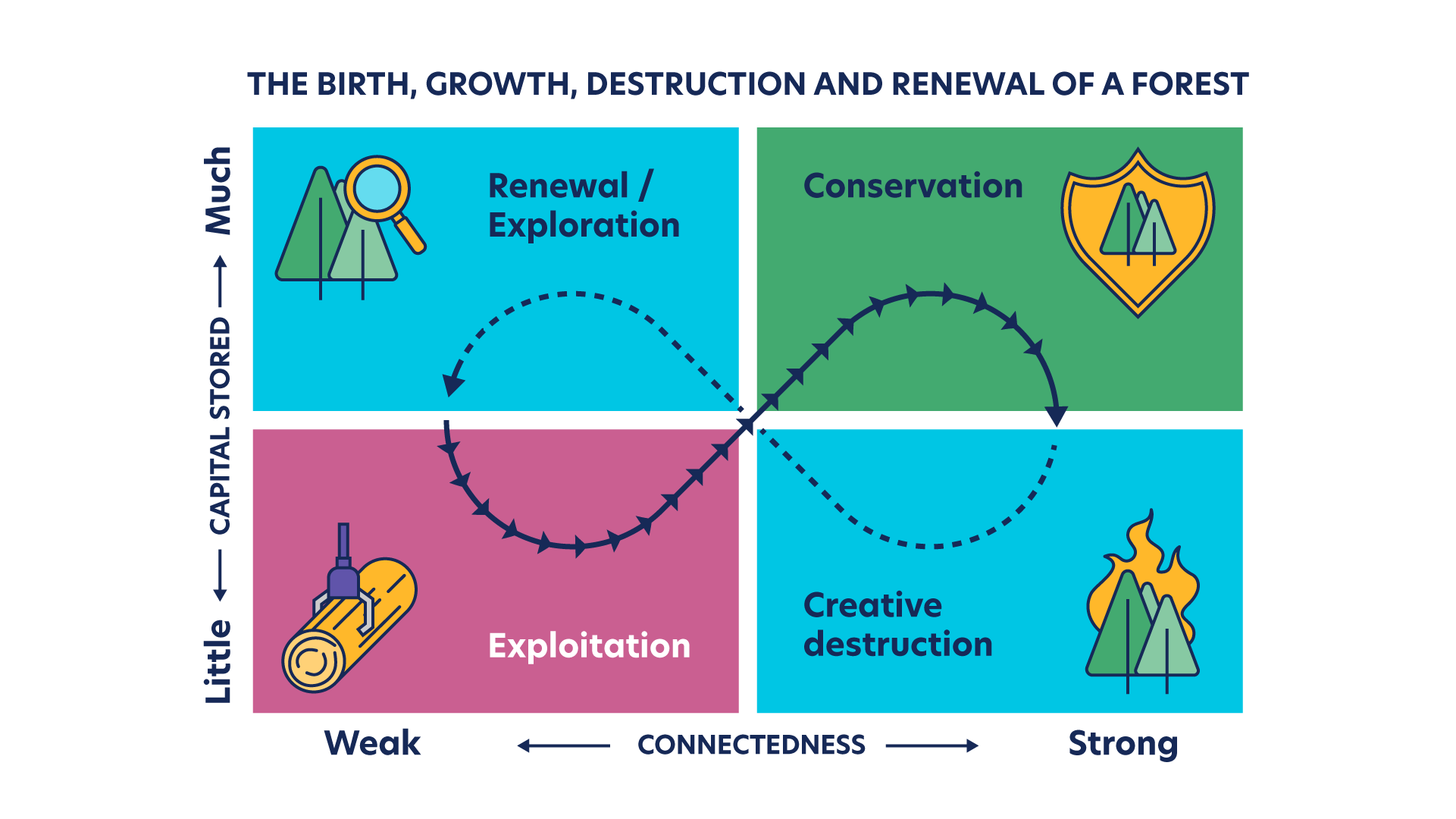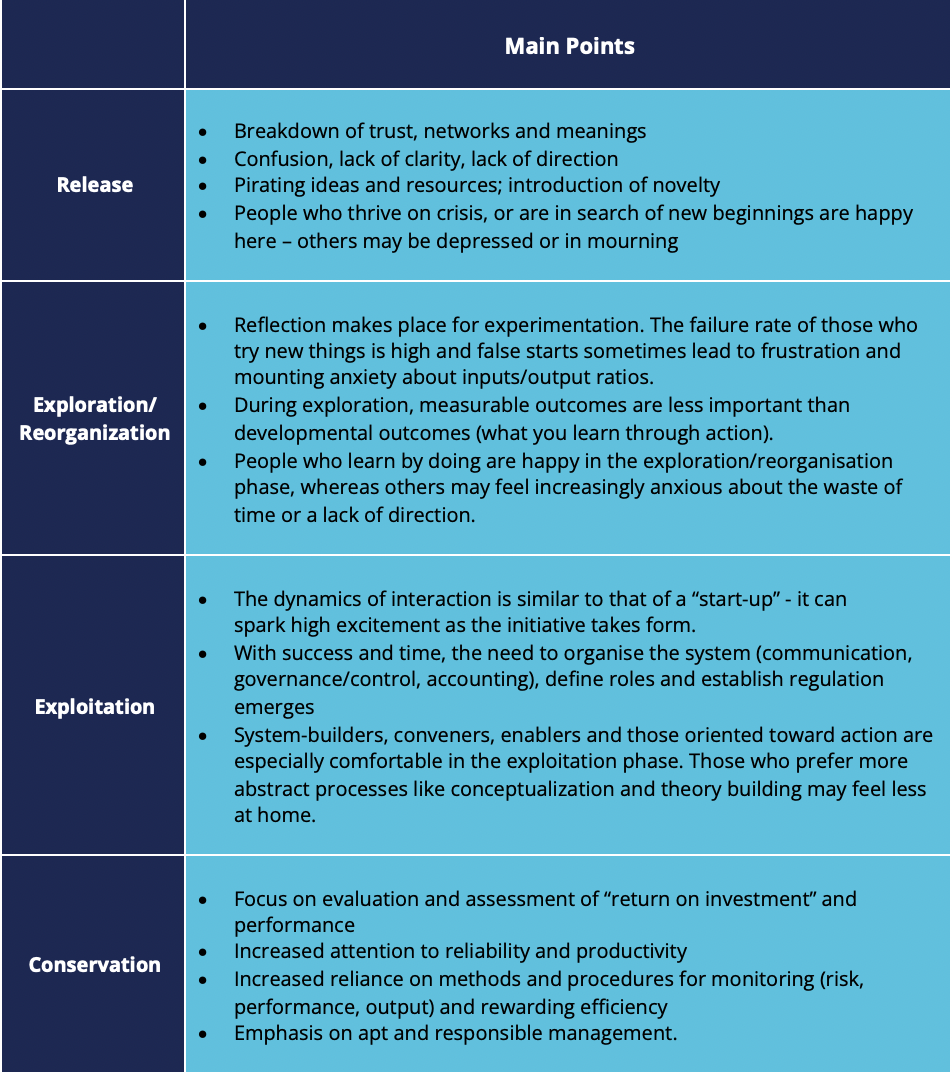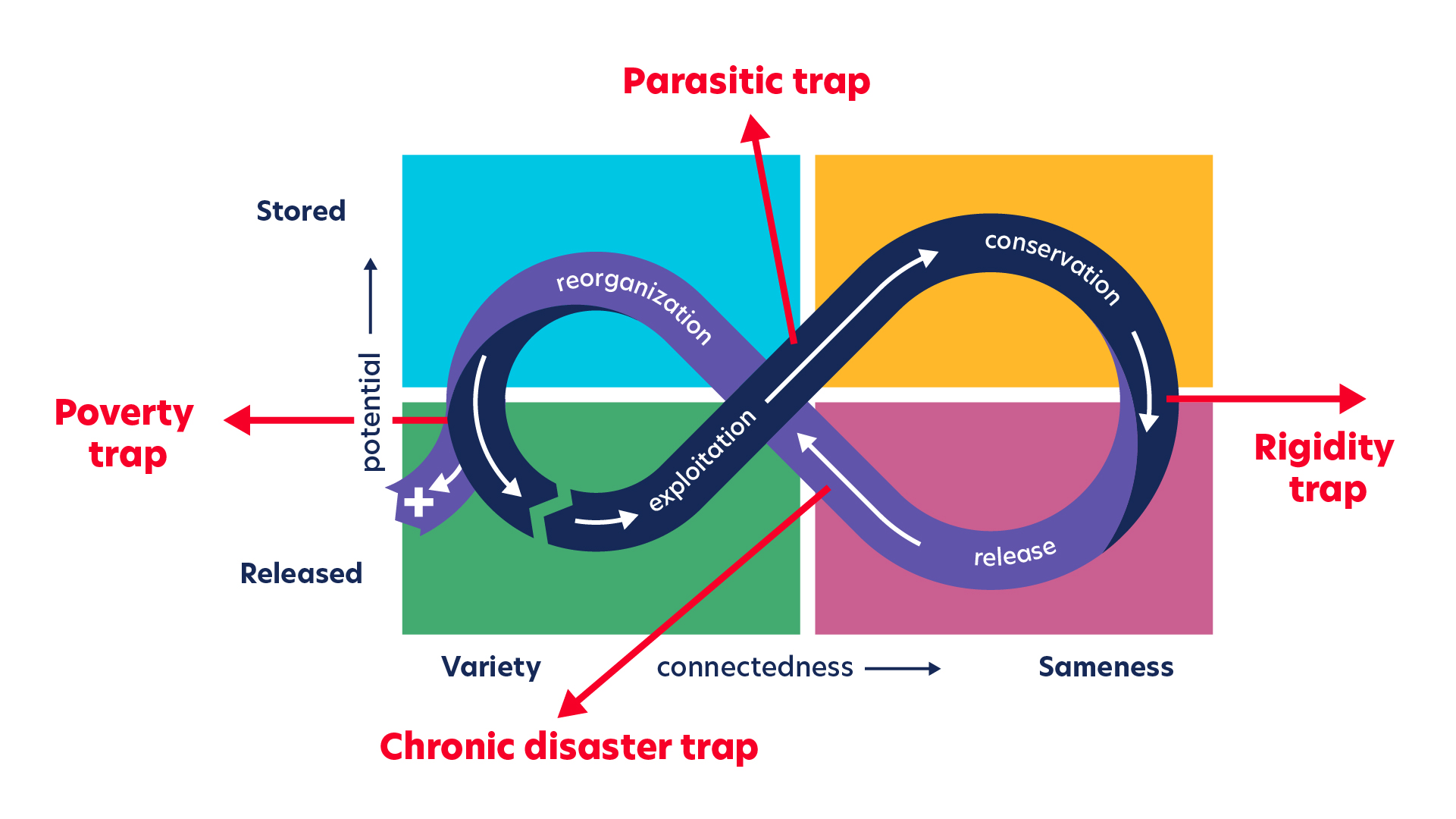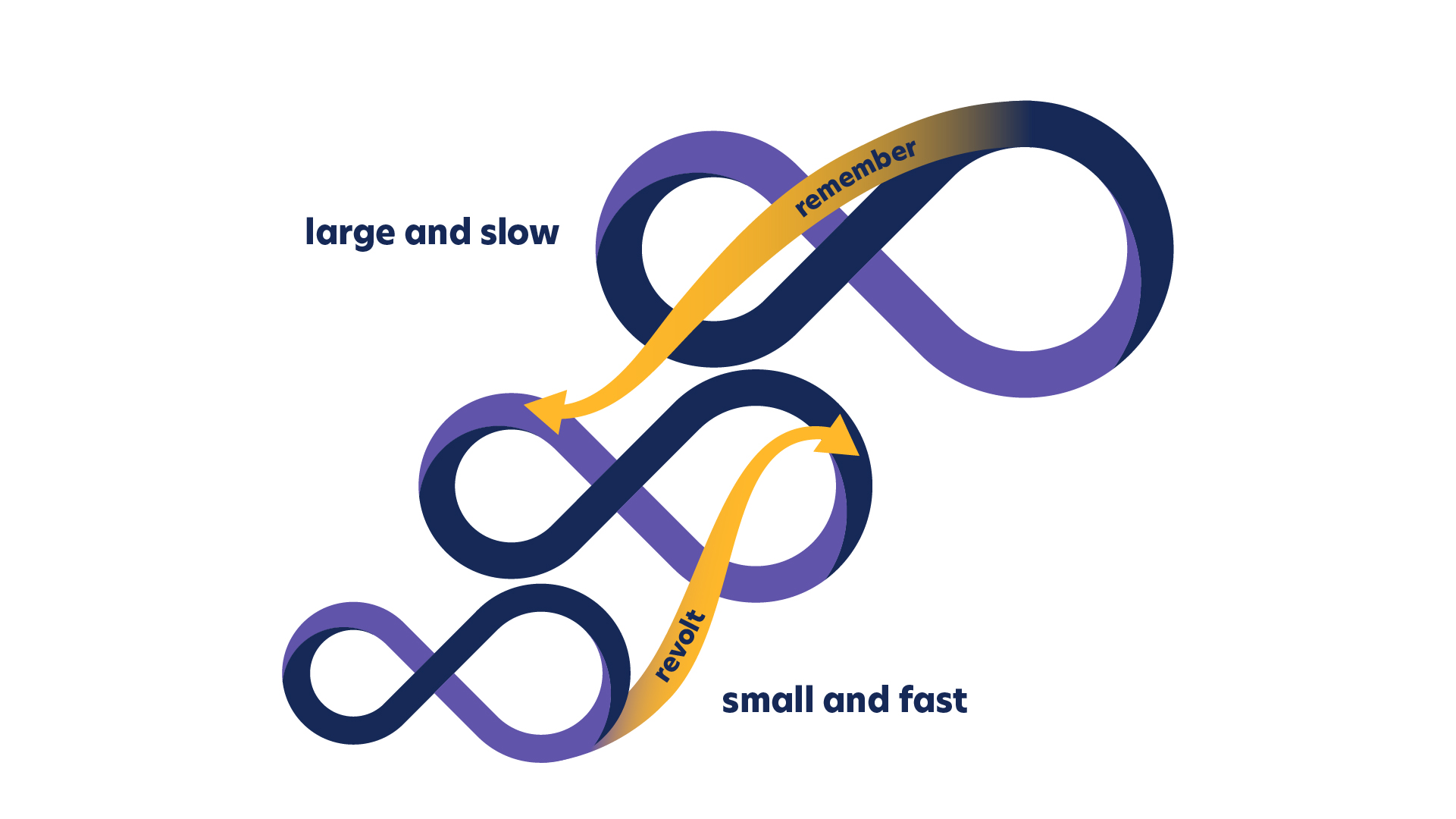By the end of this unit, participants will be able to:
- Describe how resilience supports or hinders social innovation.
- Determine where a project or initiative stands on its journey to change.
- Recognize the traps that can prevent an innovation/idea from scaling successfully.
- Differentiate between approaches to innovation and where in the adaptive cycle they are best applied.
Background
The model we use to illustrate the adaptive cycle of systems was developed in the context of the study of ecosystems and their dynamics. In the study of human and social systems, the adaptive cycle framework is meant to be used as a “heuristic tool”, i.e. an instrument that can support (self)-discovery and reflection.
One remarkable feature of the adaptive cycle model is that it stresses the importance of the processes of destruction and reorganization, which are often overlooked in favour of the processes of growth and conservation. A complete picture of systems dynamics needs to include destruction and reorganization as well. As such, the adaptive cycle can be understood to revolve around two phases, each encompassing two stages and the transition from one to the other. The first, often referred to as the “front loop”, is the slow, incremental phase of growth and accumulation. The second, referred to as the “back loop”, is the rapid phase of reorganization leading to renewal.
The idea that change can be the result of adaptive processes that are cyclical and the connected notion of resilience can be especially helpful to understanding where we are in our work, in our lives and in our intentions. As a heuristic tool, the adaptive cycle model can help assess a project’s current potential for growth, determine whether it needs resources, or whether it would be beneficial to let go of some elements that are preventing it from moving forward.
Core Concepts
Resilience
Resilience is the capacity of a system to absorb disturbance and reorganize while undergoing change, yet? still retain essentially the same function, structure, identity and feedback. Contrary to what is often assumed, in the context of transformative, systems-level innovation, resilience is neither just about persistence nor just about change; it is about balancing and integrating both.
We often talk about building resilience as a form of growth or stability. We want people to be able to handle difficult situations, to be able to be hurt or shocked or upset, but to find a way to work through it. However, we don’t often talk about resilience as involving a reduction of growth. When the rules, regulations or beliefs that determine a system prevent the kind of change we would like to see, depending on the current state of the system, resilience may in fact involve degrowth.
Resilience is how we survive – as ecosystems, as societies. Misunderstanding what resilience involves may prevent adaptation and block our path to change. In a phase of growth, a system needs to adapt and this requires stability and strength. However, in a phase of reorganisation and creative change a system needs to transform, stability and strength are not desirable features of systems that need to transform.
The concept of systems resilience is best understood through an account of the cycle of change in systems. The Adaptive Cycle Model provides us with just such a framework.
The Adaptive Cycle Model
Figure 3.1. The Adaptive Cycle of Systems.
The Adaptive Cycle consists of 2 loops. The “front loop” – a half loop really – resembles the “S-curve”. Some may be familiar with the concept of the S-curve, often cited in the context of commercialisation (the diffusion curve) or to model the spread of an infection like Covid 19 in epidemiological theory.
- The S-curve (from quadrant r to quadrant K in the Adaptive Cycle diagram) represents growth at the lower left end and maturity at the top right end.
- The “back loop” (from quadrant a to quadrant omega in the Adaptive Cycle diagram) tracks the process that starts after a project reaches maturity, when resources which had been holding a project or endeavour in place are released and the project goes through a period of reorganization. This is understood to be when and where innovation usually happens.
- Together, the front loop and the back loop represent a state of balance or equilibrium in the system. After a period of growth (front-loop), there is a period of letting go and reorganization (back-loop), that feeds into a new period of growth and so forth.
In the period that progresses from exploitation to conservation (front-loop) – connectedness and stability increase and a mass of capital is slowly accumulated and stored. According to ecosystem theory, this is a competitive process that leads to a few species or organisations or ideas (depending on the type of system considered) becoming dominant. The accumulated capital is then sequestered to support the growing, maturing ecosystem which corresponds to a gradual increase in the potential for the emergence of other kinds of ecosystems and futures.
In the case of economic and social systems, the accumulating potential may take the form of a progressive increase in skills or incremental growth of networks of human relationships and mutual trust across the progression represented by the front loop. Potential developed in the form of skills, relationships and trust has the distinctive character that it can be used in one setting and still be available, even in a transformed system.
Resilience through Change
As long as a system continues to move through the adaptive cycle, it can be said to be resilient. The danger resides in the spaces where transitions happen, between phases, where a system can get trapped and can’t move into the next phase of the adaptive cycle, thereby losing its resilience.
Illustration: The adaptive cycle of a forest
Figure 3.2. The Adaptive Cycle of a Forest.
Let us illustrate the type of resilience through change which the Adaptive Cycle affords with the example of a forest. This will also help refine key concepts: release/creative destruction, reorganization/exploration, exploitation and conservation.
Ecological systems are often cited to illustrate change in social innovation work because their behaviours share commonalities and have been bolstered by the advent of biomimicry approaches (i.e. approaches inspired by nature) in the realms of innovation, systems change and systemic design.
The Adaptive Cycle in Human Systems
Human systems, (e.g. societies, institutions) are also subject to the adaptive cycle: ideas are born, they grow, they can change over time to the point of disappearing and they are also capable of renewal.
Figure 3.3. The Adaptive Cycle Main Takeaways.
Transitions and Traps
Although our schematic representational of the adaptive cycle suggests a flow of people and resources that is continuous, in reality, the loop is not always completed from start to finish.
The movement from one phase to the next is known as a “critical transition”. These points of transitions are critical because transitions can be unpredictable, which can make for a difficult passage where innovation and change get “trapped”. Successful transition from one phase to another demands a fundamental reconfiguration. If innovation gets trapped at a transition point and the system loses resilience, repairing it may be costly and difficult.
Generally speaking, each critical transition requires the system to overcome the risks associated with a loss of coherence and/or resistance to change. This however requires the system to have the capacity to transform and involves a combination of transformational leadership skills, the availability of new and often different kinds of social connections or relationships, which itself involves re-alignments of external resource and support.
Figure 3.4. Transition Traps.
There are however specific points at which the adaptive cycle can be impeded and predictably forced to adjust back to its previous state, namely at each of the points of transition between the phases of the adaptive cycle. Because these obstacles are predictable, we can see them as traps that need to be avoided. Below, we describe all four of them.
Cross-level Interactions
Systems overlap and are connected in a rich and multilayered manner. This is especially obvious when we consider that systems exist at different scales or levels: individual, organisational and interorganisational (as we saw in Unit 1).
“The smaller, faster, nested levels invent, experiment and test, while the larger, slower levels stabilize, and conserve accumulated memory of system dynamics. In this way, the slower and larger levels set the conditions within which faster and smaller ones function. Thus, a forest stand moderates the climate within the stand to narrow the range of temperature variation that the species experience.”
– Resiliency Alliance, https://www.resalliance.org/panarchy
In any given human setting, a number of systems will overlap and may entertain intricate relations. Smaller systems may be nested within larger systems, which are in turn nested in larger systems. Each of these systems is in a process of growth, conservation, release and reorganization. At the macro level however, i.e. at the level of the systems that represent our culture, our belief systems, our laws, or ways of being in the world, change happens very slowly. This is something our experience of the social domain confirms quite easily: social beliefs around smoking changed very slowly, as did the beliefs that led to acceptance of 2SLGBTQ+ people and same sex marriage.
Figure 3.5. Systems Panarchy.
Social innovation involves the destabilizing of these higher-, macro-level macro structures through creative destruction. Generally speaking, the point at which the greater impact can be achieved by “moving up” through the levels of embedded systems is also when that system has reached maturity. To produce outcomes, social innovation requires an increased ability to push an idea and re-imagine and re-configure impact to bring it to bear on the “next level”.
Systems are nested and tend to overlap as we have discussed in this unit. This is especially obvious when we consider that systems interact across a hierarchy of structured “levels”. A panarchy is a representation of connected systems as a nested hierarchy.
There can be multiple connections between the different phases of a system a one level and the phases of systems at another level. As a rule, the higher levels can be understood to evolve more slowly and to set the conditions within which smaller systems function and evolve at a faster rate. For instance, the smaller, faster, nested levels may invent, experiment and test (they “revolt”), while the larger, slower levels stabilize and conserve accumulated memory of system dynamics (they “remember”).
Cross scale interations explains why the rate of change in a system slows as the complexity increases and why the impact of innovation is greater at the larger/higher levels of the system.
Click here for more on Panarchy.
Disruptive, Bridging and Receptive Innovation Actors
To foster the conditions for social innovation and create systemic change, different actors must play different roles in concert, yet sometimes on very different timescales. There are three main categories of roles for actors in a social innovation ecosystem: disruptive, bridging and receptive roles.
The idea that there are only three categories of roles is of course a simplification and the conditions of systemic change are subject to more nuance. But the distinction between disruptive, bridging and receptive roles is helpful when it comes to identifying the kind of contribution that may feel right for actors and it adds a layer of understanding to the reasons why social innovation is getting stuck.
There is an important difference between the bridging and receptive role in innovation contexts, even though the same person or organization may, in some cases, play both roles. The bridging agent in innovation is often an intermediary organization, department, funder/investor. Bridging agent can help with the introduction of an innovation, whether it is through the provision of funding or by helping make the concept more accessible.
Actors in bridging roles however are not expected to implement the idea or innovation on their own. The implementing, diffusing and supporting adoption of an innovation also involves innovation actors in receptive roles. Receptive roles are often well established in large institutions, e.g. hospital, schools, government. Agents in a receptive role will typically have the capacity to introduce a new concept and insure that is it well understood and they will have the relationships that will make it possible to deploy the idea within their institutional.
Resilience is the capacity of a system to absorb disturbance and reorganize while undergoing change. It is neither about persistence nor change on their own, but about balancing and integrating both into an adaptive cycle.
Adaptability is the capacity of individuals within the system to maintain or manage its resilience through continuous invention and adjustments. Adaptability requires the capacity to understand when and where an actor finds themself in the system and how they can prepare, lead or implement the change needed.
The Adaptive Cycle illustrates the flow of energy and resources over the course of a system’s evolution. During release an idea is born, a new beginning that often comes with a breakdown of networks and meanings, and requires letting go of what is familiar.
During reorganization and/or exploration, the idea is developed, this often requires a great deal of experimentation which may lead to initiatives whose outcomes may be difficult to assess and where return on investment is not immediately tangible. During exploitation, the idea is launched as a product, process, organization or something else. Demand for delivery and productivity emerge, increasing the need for organizing. During conservation, the idea has “established” itself and the innovation is adopted. This is the time to manage aptly, measure returns and performance, and focus on reliability and productivity.
The Adaptive Cycle isn’t always completed from start to finish. At various stages, it can “get stuck”, and the cycle adjusts back to its previous point. To move past the issue, it is useful to keep an eye for some of the better known issues or trap system will encounter in transition from one phase to another.
- Rigidity trap – between Conservation to Release. Rigidity threatens system when leadership won’t allow resources to be released to allow in new ideas, which sometimes happen when the cost/risk is seen as too high.
- Chronic disaster trap – between Release to Reorganization. As resources are released some lose their way, making it difficult or impossible to move into the exploration phase impossible and begin testing out new ideas
- Poverty trap – between Reorganization to Exploitation. When you are unable to reach a consensus on an idea, or unable to direct resources to introduce the best idea into the ecosystem.
- Parasitic trap – between Exploitation to Conservation. People may steal your idea as it begins to experience success or otherwise challenge intellectual property, making it impossible for an organization or person to reap the benefit of the investment they made up until now. Systems get stuck when they are unable to reconcile with the type of standardization needed to move into the conservation space.
To foster the conditions for positive social innovation actors in different roles must work in concert — sometimes on very different timescales — to create systemic change.
Disruptive Role. Those in disruptive roles will go against the grain, push against the system, see a new way of doing things. But disruption on its own is insufficient for progress and systems change.
Bridging Role. Those in bridging roles need to be able to identify a valuable idea and translate it or adapt it so that it can be applied across the various parts of the system of interest. Bridging agents help create the conditions for success.
Receptive Role. Those in receptive roles understand the territory, and know how to “work the system” to take the idea and scale it out or up for deep impact.
Slides
Partner Engagement
Activities and Assignments



